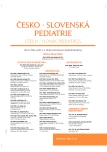Severe combined immunodeficiency with atypical phenotype – case report
Authors:
M. Purkartová 1; R. Formánková 2; O. Hrušák 2,3; M. Nováková 2,3; H. Grombiříková 4; T. Freiberger 4; M. Svaton 2,3; A. Šedivá 5; M. Magner 1,5; M. Bloomfield 1,6
Authors‘ workplace:
Pediatrická klinika 1. LF UK a Thomayerovy nemocnice, Praha
1; Klinika dětské hematologie a onkologie 2. LF UK a FN Motol, Praha
2; CLIP – Childhood Leukaemia Investigation Prague
3; Centrum kardiovaskulární a transplantační chirurgie a LF MU, Brno
4; Klinika pediatrie a dědičných poruch metabolismu 1. LF UK a VFN, Praha
5; Ústav imunologie 2. LF UK a FN Motol, Praha
6
Published in:
Čes-slov Pediat 2020; 75 (6): 356-361.
Category:
Overview
Severe combined immunodeficiency (SCID) is clinically and genetically heterogeneous group of the most severe inborn errors of immunity. The disease typically presents as a failure of antimicrobial defences due to various defects of lymphocyte development and functions. Being a life-threatening condition, SCID requires a prompt diagnosis in order to implement an appropriate management aimed towards early hematopoietic stem cell transplantation. Besides the classic forms of SCID, atypical or leaky phenotypes exist, that may manifest later in life or/and with milder symptoms.
In this report, we describe a 5-months-old infant with autosomal recessive atypical RAG2 SCID, who is the only patient diagnosed with SCID in the Czech Republic in the years 2018 and 2019.
Keywords:
SCID – severe combined immunodeficiency – lymphopenia – SCID screening – TREC – KREC – hematopoietic stem cell transplantation
Sources
1. Kumrah R, et al. Genetics of severe combined immunodeficiency. Genes Dis 2020; 7 (1): 52–61.
2. Sponzilli I, Notarangelo LD. Severe combined immunodeficiency (SCID): from molecular basis to clinical management. Acta Biomed 2011; 82 (1): 5–13.
3. Wahlstrom J, et al. Transplacental maternal engraftment and posttransplantation graft-versus-host disease in children with severe combined immunodeficiency. J Allergy Clin Immunol 2017; 139 (2): 628–633.
4. Formánková R, et al. Problematika včasného stanovení diagnózy těžkého kombinovaného imunodeficitu. Čes-slov Pediat 2007; 62 (1): 5–15.
5. Šedivá A, et al. Závažné primární imunodeficience a možnosti jejich časné diagnostiky, uvedení testu TREC/KREC. Čes-slov Pediat 2019; 74 (3): 182–187.
6. Schuetz C, et al. An immunodeficiency disease with RAG mutations and granulomas. N Engl J Med 2008; 358: 2030.
7. Heimalla J, Cowanb MJ. Long term outcomes of severe combined immunodeficiency: therapy implications. Expert Rev Clin Immunol 2017; 13 (11): 1029–1040.
8. Wahlstrom JT, et al. Hematopoietic stem cell transplantation for severe combined immunodeficiency. Curr Pediatr Rep 2015; 3 (1): 1–10.
9. Brüggemann M, et al. Standardized next-generation sequencing of immunoglobulin and T-cell receptor gene recombinations for MRD marker identification in acute lymphoblastic leukaemia; a EuroClonality-NGS validation study. Leukemia 2019; 33 (9): 2241–2253.
Labels
Neonatology Paediatrics General practitioner for children and adolescentsArticle was published in
Czech-Slovak Pediatrics

2020 Issue 6
- What Effect Can Be Expected from Limosilactobacillus reuteri in Mucositis and Peri-Implantitis?
- The Importance of Limosilactobacillus reuteri in Administration to Diabetics with Gingivitis
Most read in this issue
- Extreme hypokalaemia in familial periodic paralysis – case report
- Ascaris: a rare cause of nighttime abdominal pain in children – case report
- Brain abscess in children – overview and two case reports
- Vasculitis as a rare manifestation of Sarcoptes scabiei infestation – case report
